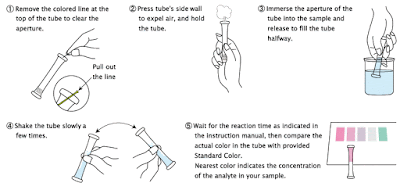Before you conduct the packtests, you need to have the required materials for preparation, experiment and recording of data. The materials and equipment you would require for testing include but not limited to:
Packtest Kits.
GPS
Note Book
Pencil/pen
3 x Half cut container
syringe
0.45µm filter
Camera/smart phone with camera.
turbidity meter
pH meter
Laptop/computer
Once you have the above equipment list, you are about to conduct the PACKTEST and other necessary measurements. But before that you must never forget to give a sample location name or sample code/ID and record the coordinates, location zone and offcourse altitude of the sample location. This will ease the management of various data of the same type.
Thereafter, you proceed with the PACKTEST procedures as outline below which is a global practice:
Sampling Procedure for PACKTEST
1. Fetch water in container and filter the water using syringe and 0.45µm filter to filter water sample and pour filtered water sample into a clear mini cylinder(half cut container).
2. Remove the colored line at the top of the tube to clear the aperture.
3. Press tube's sidewall to expel air, and hold the tube.
4. Immerse the aperture of the tube into the water sample in the mini cylinder and release to fill the tube halfway.
5. Shake the tube slowly for few seconds.
6. Wait for the reaction time as indicated in the instruction manual, and then compare the actual color in the tube with provided Standard Color. The nearest color indicates the concentration value (mg/L = ppm) of the analyte in your sample.
Concurrently set up the equipment for measuring the pH, temperature, metal conductivity and turbidity of the water sample at the same sample location for the packtest water sample taken. After the setup is complete, you take the reading carefully as the reading varies every second. It is recommended to take the best average reading.
Upon the completion of the setup and PACKTESTs, you have the data available at hand to record. In your note book you record the readings of pH, Turbidity, Temperature, metal conductivity. Then you have the other sets of data from the PACKTEST results. Each element tested has got a numbered colour range that corresponds to the concentration of that element/compound in the water sample. You record every data for the elements that are tested.
Finally you need to digitise the data and analyse the test results. To do that, you need to have a computer or a laptop. Create an excel spread sheet in your laptop or computer and enter the field data in a tabulated format. Your sample results look like the table below:
 |
| Table 1: Rapid PACKTEST Results |
Related Articles:
Rapid PACKTEST
Data Collection of Rapid PACKTEST Results
Data Analysis of Rapid PACKTEST Results
How to Conduct Rapid PACKTEST in a Well


















 News Paper Article opposing the exploration application.
News Paper Article opposing the exploration application.





